Abstract
A canine sepsis model that simulates the human cardiovascular response to septic shock was produced in 10 conscious unsedated dogs by implanting an Escherichia coli-infected clot into the peritoneum, resulting in bacteremia. By employing serial, simultaneous measurements of radionuclide scan-determined left ventricular (LV) ejection fraction (EF) and thermodilution cardiac index (CI), the end-diastolic volume index (EDVI) was calculated (EDVI = stroke volume index divided by EF). By using three different methods of quantifying serial ventricular performance (EF, shifts in the Starling ventricular function curve using EDVI vs. stroke work index, and the ventricular function curve response to volume infusion), this study provides evidence (P less than 0.01) that septic shock produces a profound, but reversible, decrease in systolic ventricular performance. This decreased performance was not seen in controls and was associated with ventricular dilatation (P less than 0.01); the latter response was dependent on an adequate volume infusion. Further studies of EDVI and pulmonary capillary wedge pressure during diastole revealed a significant, though reversible, shift (P less than 0.001) in the diastolic volume/pressure (or compliance) relationship during septic shock.
Full text
PDF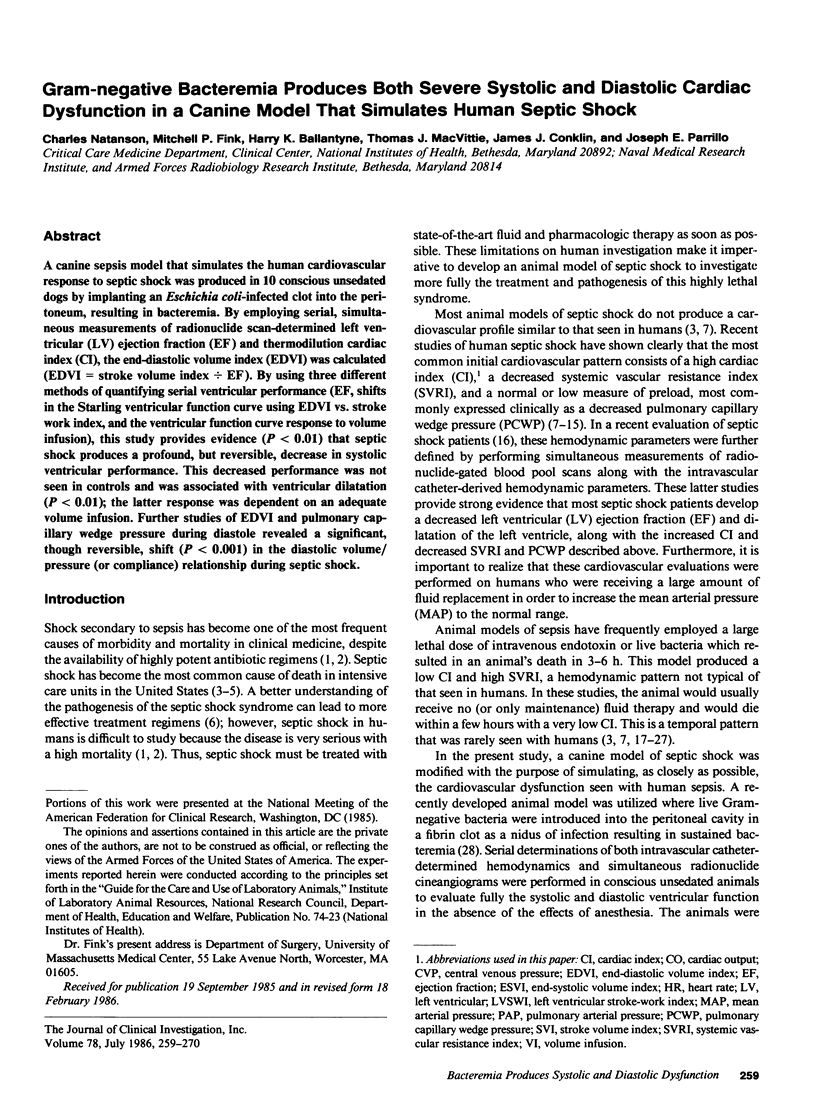
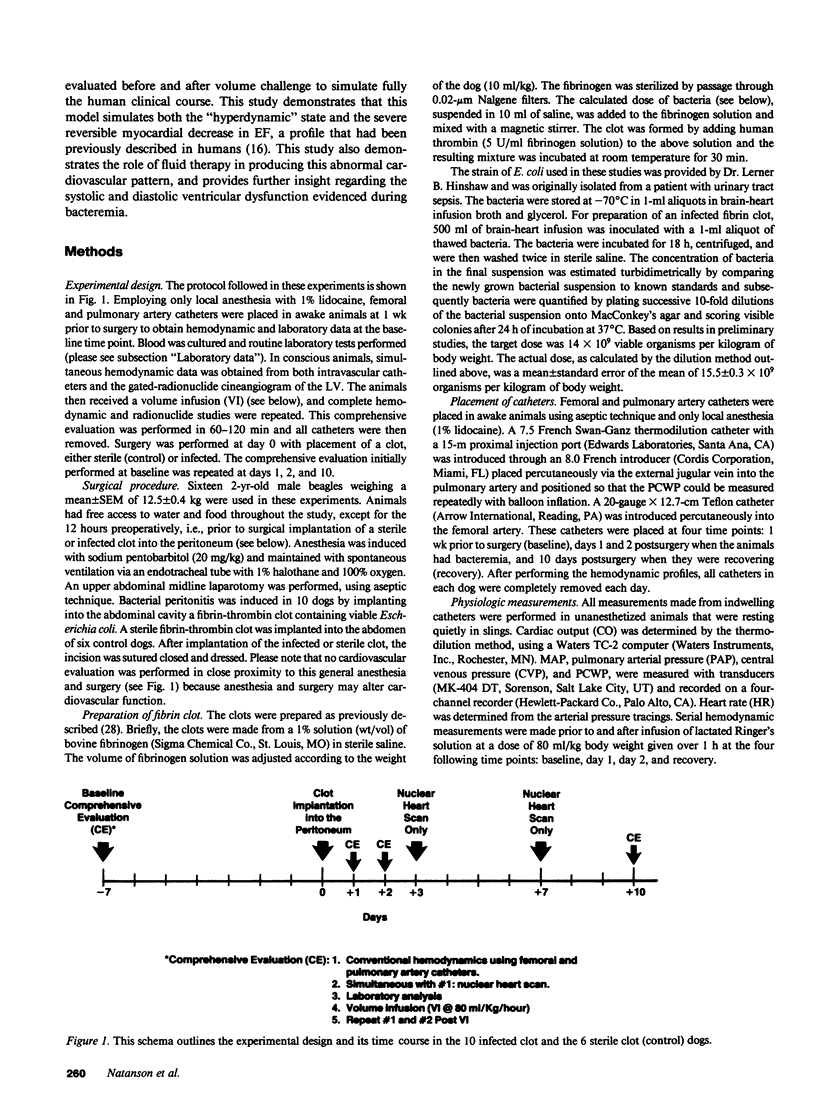

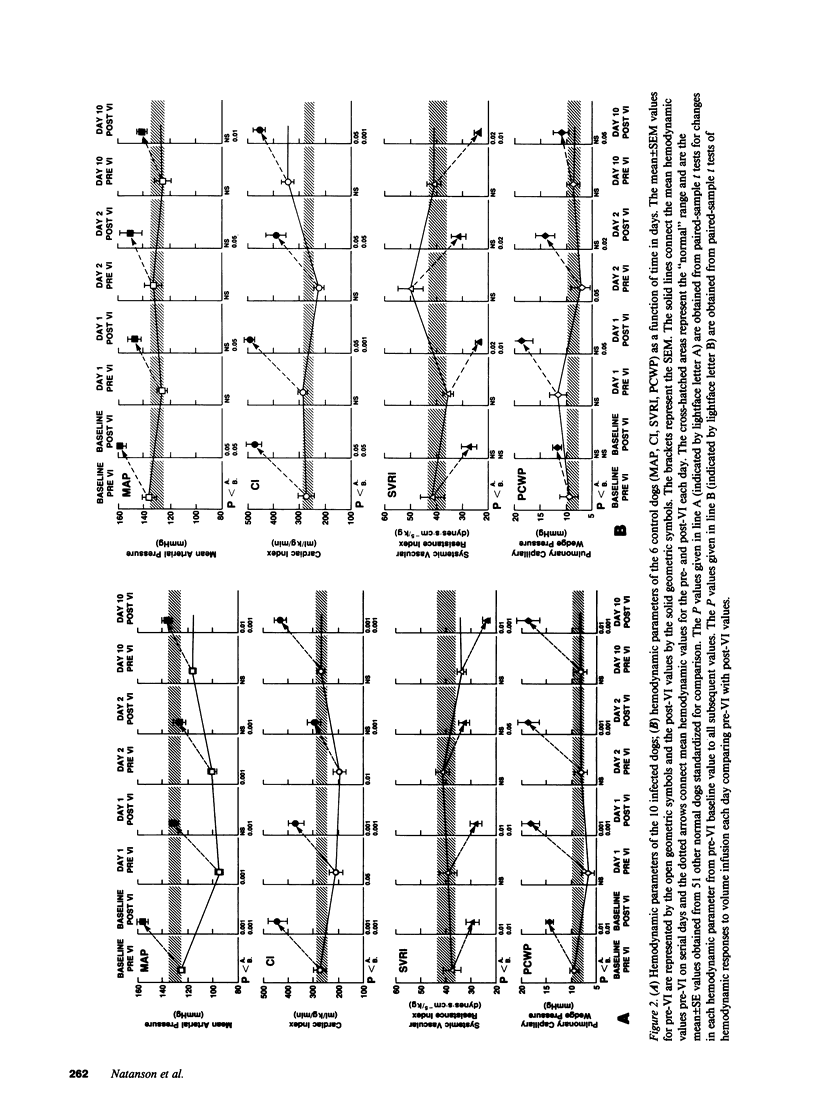
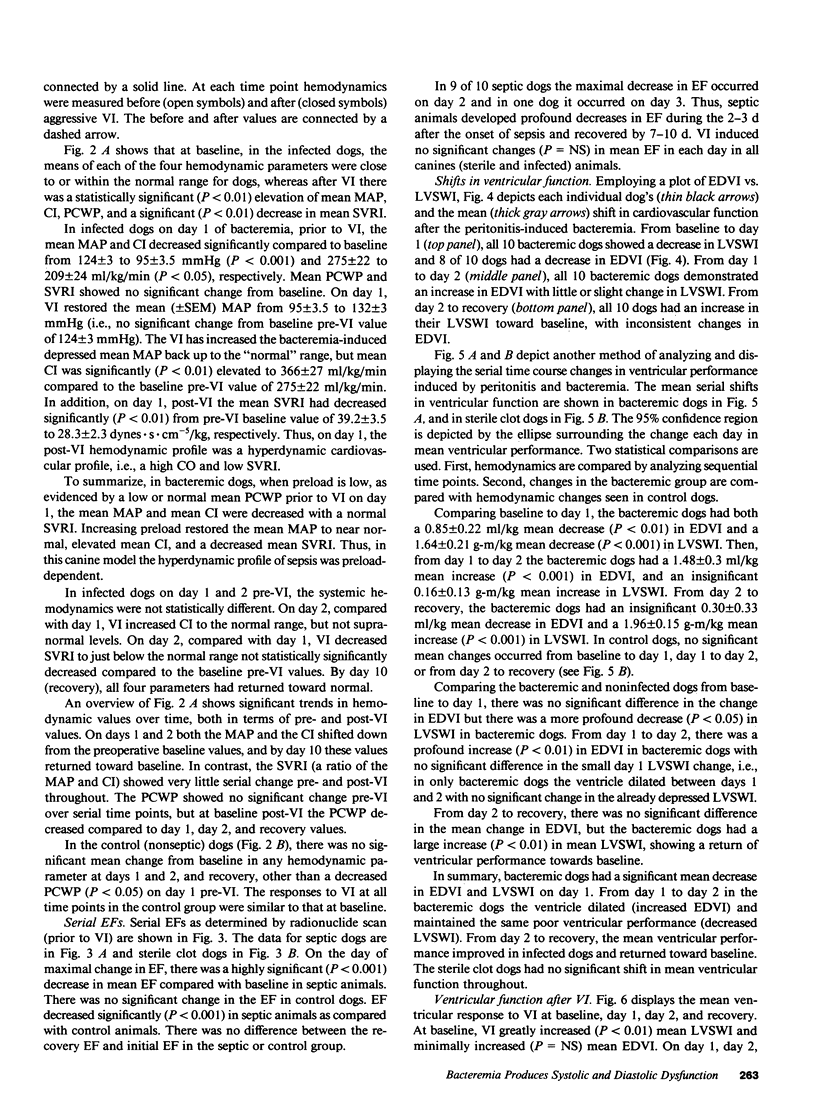
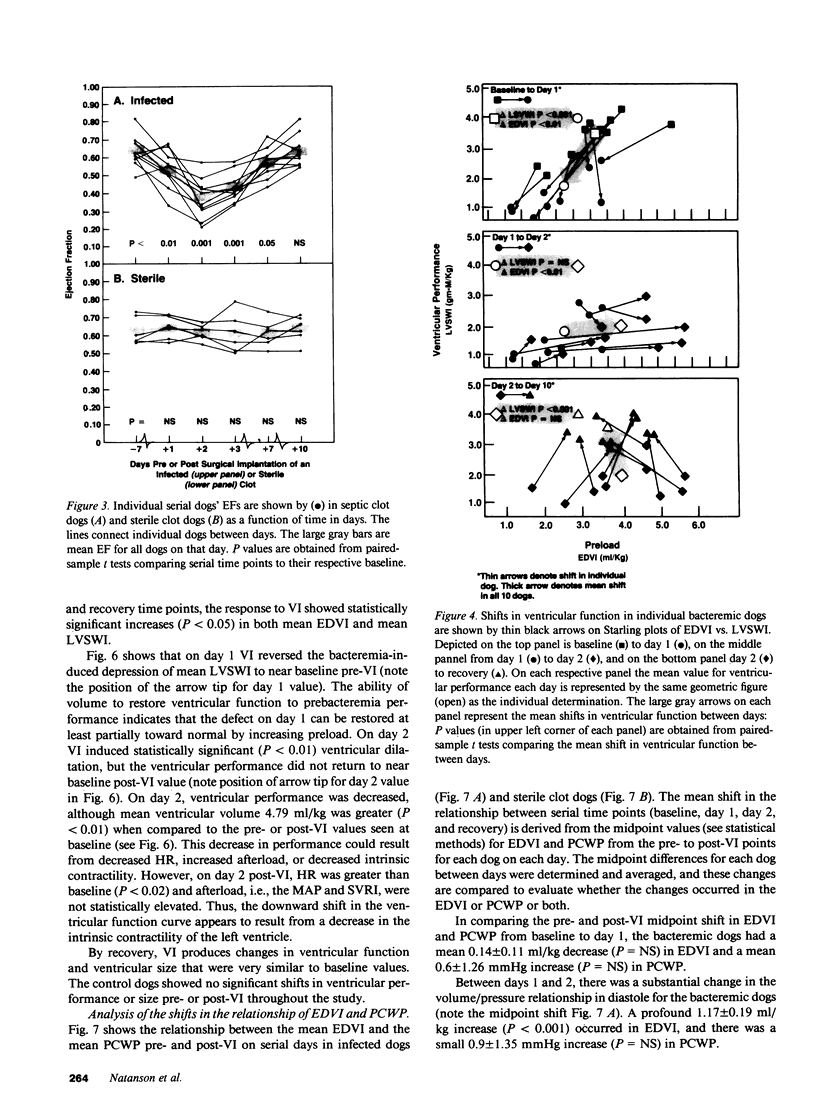
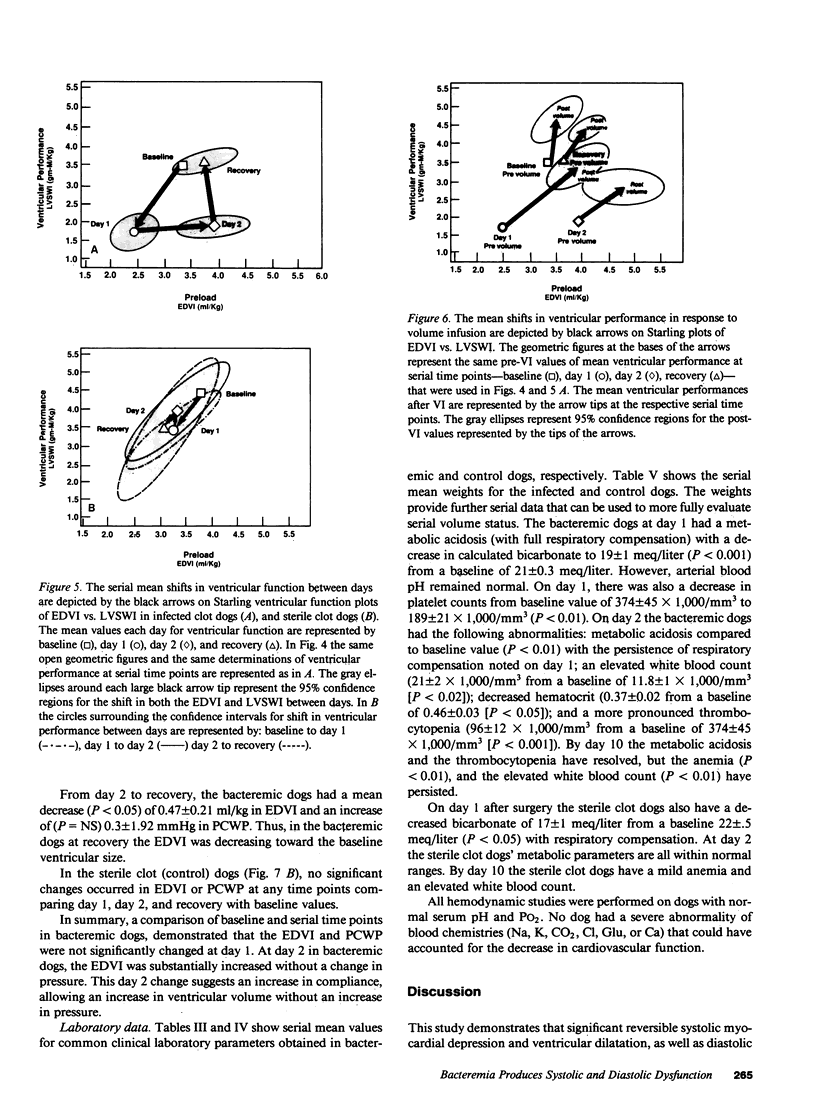
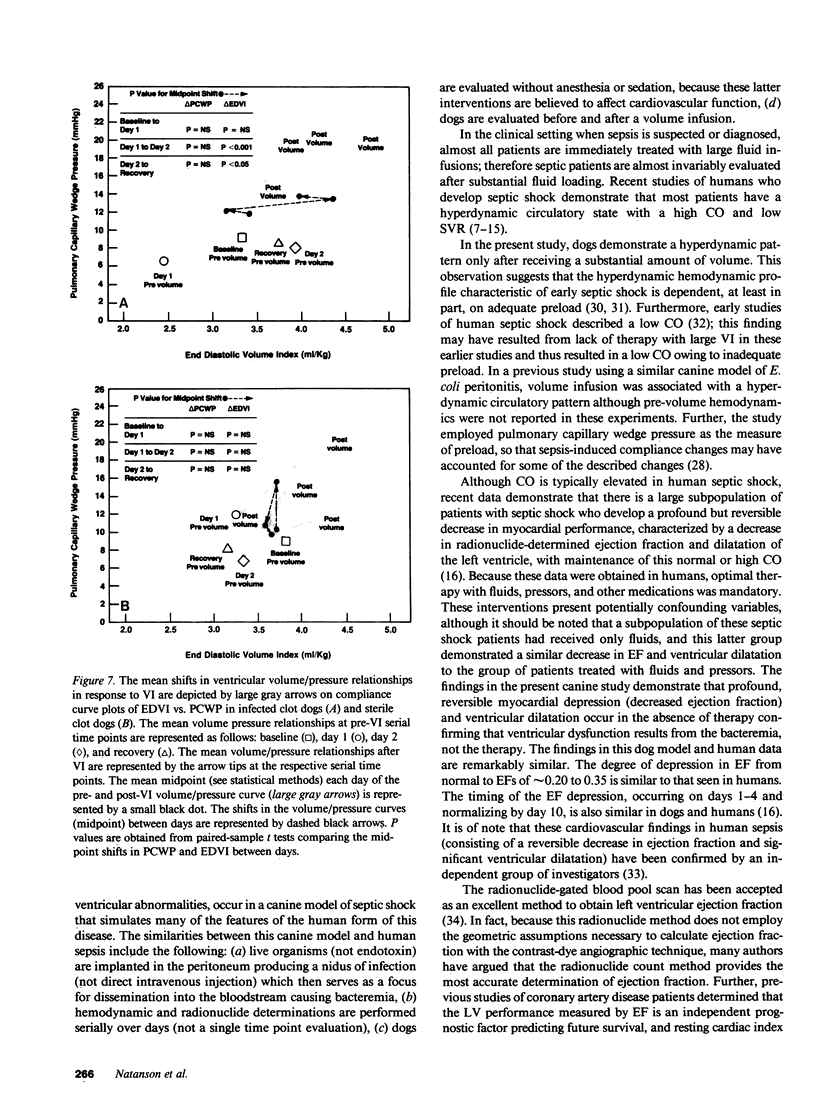
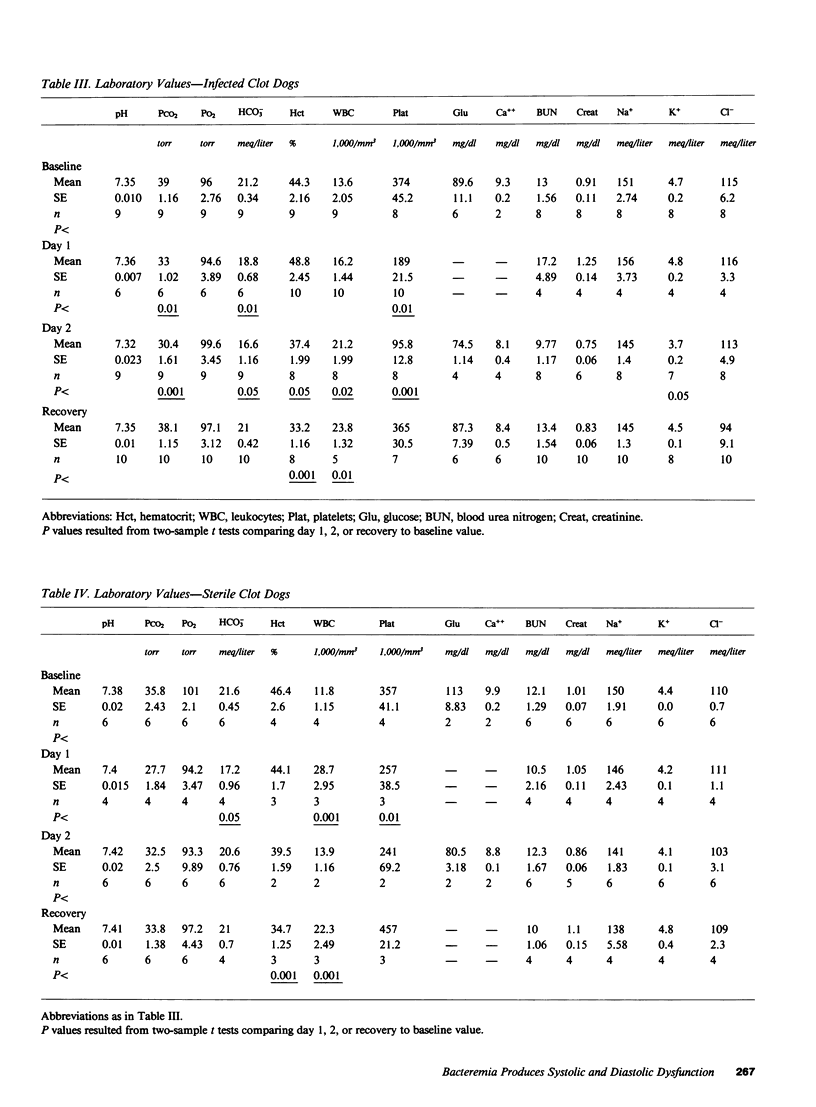
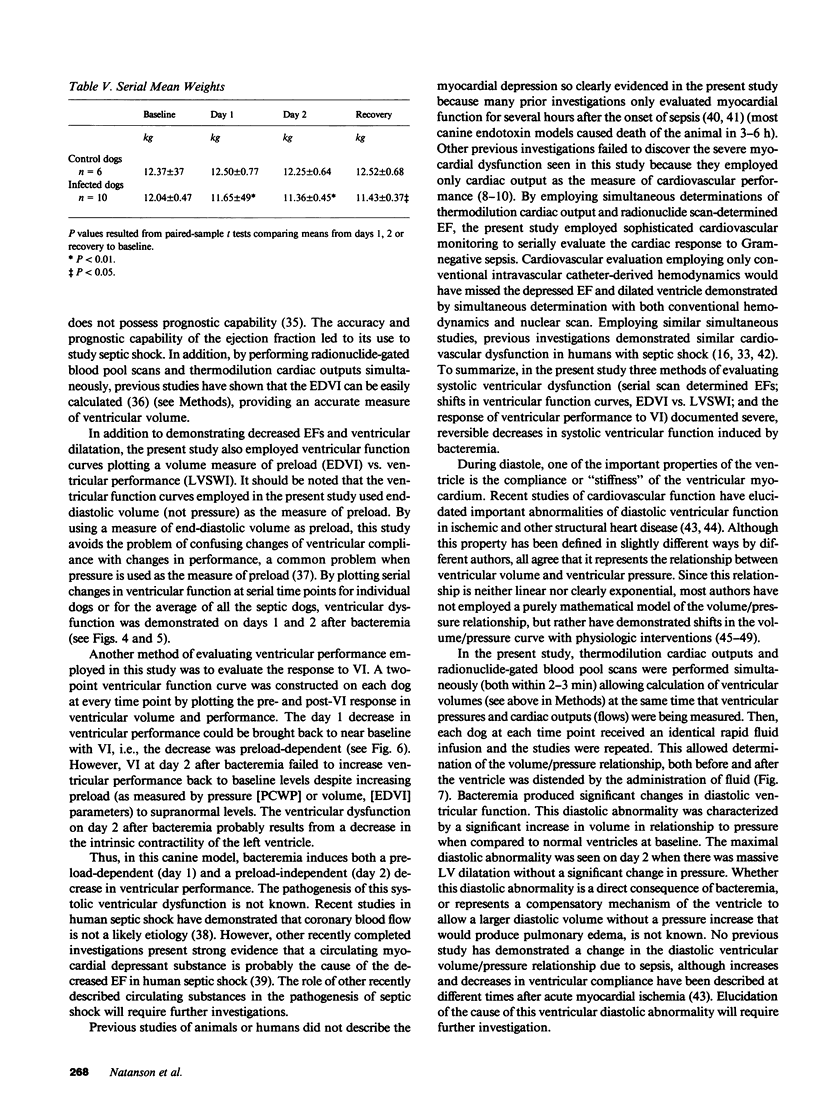
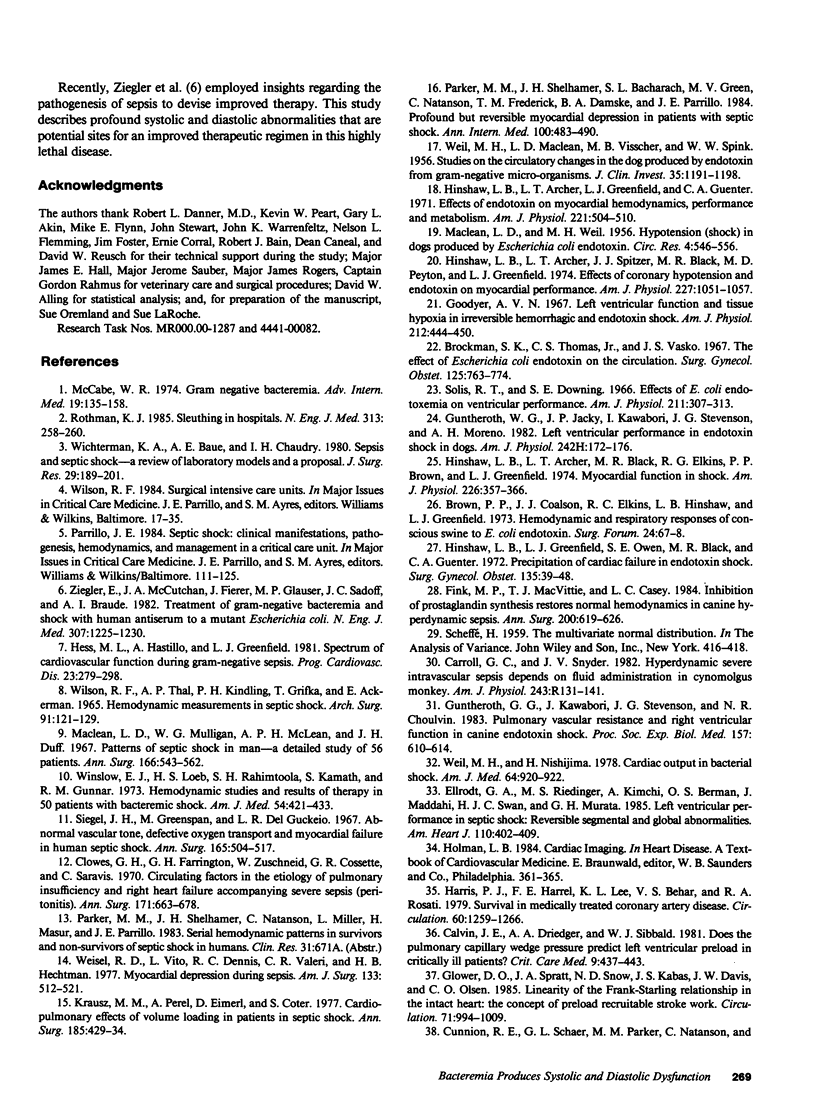
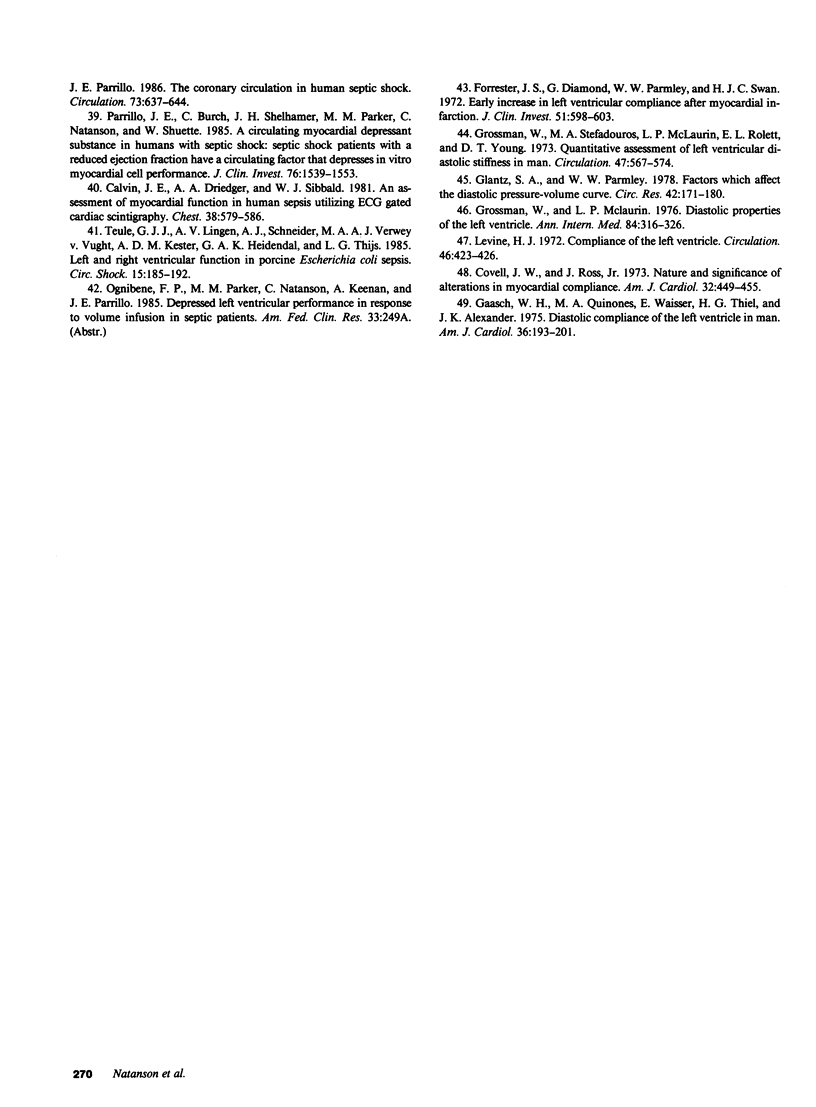
Selected References
These references are in PubMed. This may not be the complete list of references from this article.
- Brockman S. K., Thomas C. S., Jr, Vasko J. S. The effect of Escherichia coli endotoxin on the circulation. Surg Gynecol Obstet. 1967 Oct;125(4):763–774. [PubMed] [Google Scholar]
- Brown P. P., Coalson J. J., Elkins R. C., Hinshaw L. B., Greenfield L. J. Hemodynamic and respiratory responses of conscious swine to Escherichia coli endotoxin. Surg Forum. 1973;24:67–68. [PubMed] [Google Scholar]
- Calvin J. E., Driedger A. A., Sibbald W. J. An assessment of myocardial function in human sepsis utilizing ECG gated cardiac scintigraphy. Chest. 1981 Nov;80(5):579–586. doi: 10.1378/chest.80.5.579. [DOI] [PubMed] [Google Scholar]
- Calvin J. E., Driedger A. A., Sibbald W. J. Does the pulmonary capillary wedge pressure predict left ventricular preload in critically ill patients? Crit Care Med. 1981 Jun;9(6):437–443. doi: 10.1097/00003246-198106000-00001. [DOI] [PubMed] [Google Scholar]
- Carroll G. C., Snyder J. V. Hyperdynamic severe intravascular sepsis depends on fluid administration in cynomolgus monkey. Am J Physiol. 1982 Jul;243(1):R131–R141. doi: 10.1152/ajpregu.1982.243.1.R131. [DOI] [PubMed] [Google Scholar]
- Clowes G. H., Jr, Farrington G. H., Zuschneid W., Cossette G. R., Saravis C. Circulating factors in the etiology of pulmonary insufficiency and right heart failure accompanying severe sepsis (peritonitis). Ann Surg. 1970 May;171(5):663–678. doi: 10.1097/00000658-197005000-00005. [DOI] [PMC free article] [PubMed] [Google Scholar]
- Covell J. W., Ross J., Jr Nature and significance of alterations in myocardial compliance. Am J Cardiol. 1973 Sep 20;32(4):449–455. doi: 10.1016/s0002-9149(73)80035-9. [DOI] [PubMed] [Google Scholar]
- Cunnion R. E., Schaer G. L., Parker M. M., Natanson C., Parrillo J. E. The coronary circulation in human septic shock. Circulation. 1986 Apr;73(4):637–644. doi: 10.1161/01.cir.73.4.637. [DOI] [PubMed] [Google Scholar]
- Ellrodt A. G., Riedinger M. S., Kimchi A., Berman D. S., Maddahi J., Swan H. J., Murata G. H. Left ventricular performance in septic shock: reversible segmental and global abnormalities. Am Heart J. 1985 Aug;110(2):402–409. doi: 10.1016/0002-8703(85)90163-2. [DOI] [PubMed] [Google Scholar]
- Fink M. P., MacVittie T. J., Casey L. C. Inhibition of prostaglandin synthesis restores normal hemodynamics in canine hyperdynamic sepsis. Ann Surg. 1984 Nov;200(5):619–626. doi: 10.1097/00000658-198411000-00011. [DOI] [PMC free article] [PubMed] [Google Scholar]
- Forrester J. S., Diamond G., Parmley W. W., Swan H. J. Early increase in left ventricular compliance after myocardial infarction. J Clin Invest. 1972 Mar;51(3):598–603. doi: 10.1172/JCI106849. [DOI] [PMC free article] [PubMed] [Google Scholar]
- Gaasch W. H., Quinones M. A., Waisser E., Thiel H. G., Alexander J. K. Diastolic compliance of the left ventricle in man. Am J Cardiol. 1975 Aug;36(2):193–201. doi: 10.1016/0002-9149(75)90525-1. [DOI] [PubMed] [Google Scholar]
- Glantz S. A., Parmley W. W. Factors which affect the diastolic pressure-volume curve. Circ Res. 1978 Feb;42(2):171–180. doi: 10.1161/01.res.42.2.171. [DOI] [PubMed] [Google Scholar]
- Glower D. D., Spratt J. A., Snow N. D., Kabas J. S., Davis J. W., Olsen C. O., Tyson G. S., Sabiston D. C., Jr, Rankin J. S. Linearity of the Frank-Starling relationship in the intact heart: the concept of preload recruitable stroke work. Circulation. 1985 May;71(5):994–1009. doi: 10.1161/01.cir.71.5.994. [DOI] [PubMed] [Google Scholar]
- Goodyer A. V. Left ventricular function and tissue hypoxia in irreversible hemorrhagic and endotoxin shock. Am J Physiol. 1967 Feb;212(2):444–450. doi: 10.1152/ajplegacy.1967.212.2.444. [DOI] [PubMed] [Google Scholar]
- Grossman W., McLaurin L. P. Diastolic properties of the left ventricle. Ann Intern Med. 1976 Mar;84(3):316–326. doi: 10.7326/0003-4819-84-3-316. [DOI] [PubMed] [Google Scholar]
- Grossman W., Stefadouros M. A., McLaurin L. P., Rolett E. L., Young D. T. Quantitative assessment of left ventricular diastolic stiffness in man. Circulation. 1973 Mar;47(3):567–574. doi: 10.1161/01.cir.47.3.567. [DOI] [PubMed] [Google Scholar]
- Guntheroth W. G., Kawabori I., Stevenson J. G., Cholvin N. R. Pulmonary vascular resistance and right ventricular function in canine endotoxin shock. Proc Soc Exp Biol Med. 1978 Apr;157(4):610–614. doi: 10.3181/00379727-157-40107. [DOI] [PubMed] [Google Scholar]
- Harris P. J., Harrell F. E., Jr, Lee K. L., Behar V. S., Rosati R. A. Survival in medically treated coronary artery disease. Circulation. 1979 Dec;60(6):1259–1269. doi: 10.1161/01.cir.60.6.1259. [DOI] [PubMed] [Google Scholar]
- Hess M. L., Hastillo A., Greenfield L. J. Spectrum of cardiovascular function during gram-negative sepsis. Prog Cardiovasc Dis. 1981 Jan-Feb;23(4):279–298. doi: 10.1016/0033-0620(81)90017-7. [DOI] [PubMed] [Google Scholar]
- Hinshaw L. B., Archer L. T., Black M. R., Elkins R. C., Brown P. P., Greenfield L. J. Myocardial function in shock. Am J Physiol. 1974 Feb;226(2):357–366. doi: 10.1152/ajplegacy.1974.226.2.357. [DOI] [PubMed] [Google Scholar]
- Hinshaw L. B., Archer L. T., Greenfield L. J., Guenter C. A. Effects of endotoxin on myocardial hemodynamics, performance, and metabolism. Am J Physiol. 1971 Aug;221(2):504–510. doi: 10.1152/ajplegacy.1971.221.2.504. [DOI] [PubMed] [Google Scholar]
- Hinshaw L. B., Archer L. T., Spitzer J. J., Black M. R., Peyton M. D., Greenfield L. J. Effects of coronary hypotension and endotoxin on myocardial performance. Am J Physiol. 1974 Nov;227(5):1051–1057. doi: 10.1152/ajplegacy.1974.227.5.1051. [DOI] [PubMed] [Google Scholar]
- Hinshaw L. B., Greenfield L. J., Owen S. E., Black M. R., Guenter C. A. Precipitation of cardiac failure in endotoxin shock. Surg Gynecol Obstet. 1972 Jul;135(1):39–48. [PubMed] [Google Scholar]
- Krausz M. M., Perel A., Eimerl D., Cotev S. Cardiopulmonary effects of volume loading in patients in septic shock. Ann Surg. 1977 Apr;185(4):429–434. doi: 10.1097/00000658-197704000-00010. [DOI] [PMC free article] [PubMed] [Google Scholar]
- Levine H. J. Compliance of the left ventricle. Circulation. 1972 Sep;46(3):423–426. doi: 10.1161/01.cir.46.3.423. [DOI] [PubMed] [Google Scholar]
- MACLEAN L. D., SPINK W. W., VISSCHER M. B., WEIL M. H. Studies on the circulatory changes in the dog produced by endotoxin from gram-negative microorganisms. J Clin Invest. 1956 Nov;35(11):1191–1198. doi: 10.1172/JCI103373. [DOI] [PMC free article] [PubMed] [Google Scholar]
- MACLEAN L. D., WEIL M. H. Hypotension (shock) in dogs produced by Escherichia coli endotoxin. Circ Res. 1956 Sep;4(5):546–556. doi: 10.1161/01.res.4.5.546. [DOI] [PubMed] [Google Scholar]
- MacLean L. D., Mulligan W. G., McLean A. P., Duff J. H. Patterns of septic shock in man--a detailed study of 56 patients. Ann Surg. 1967 Oct;166(4):543–562. doi: 10.1097/00000658-196710000-00004. [DOI] [PMC free article] [PubMed] [Google Scholar]
- McCabe W. R. Gram-negative bacteremia. Adv Intern Med. 1974;19:135–158. [PubMed] [Google Scholar]
- Parker M. M., Shelhamer J. H., Bacharach S. L., Green M. V., Natanson C., Frederick T. M., Damske B. A., Parrillo J. E. Profound but reversible myocardial depression in patients with septic shock. Ann Intern Med. 1984 Apr;100(4):483–490. doi: 10.7326/0003-4819-100-4-483. [DOI] [PubMed] [Google Scholar]
- Parrillo J. E., Burch C., Shelhamer J. H., Parker M. M., Natanson C., Schuette W. A circulating myocardial depressant substance in humans with septic shock. Septic shock patients with a reduced ejection fraction have a circulating factor that depresses in vitro myocardial cell performance. J Clin Invest. 1985 Oct;76(4):1539–1553. doi: 10.1172/JCI112135. [DOI] [PMC free article] [PubMed] [Google Scholar]
- Rothman K. J. Sleuthing in hospitals. N Engl J Med. 1985 Jul 25;313(4):258–260. doi: 10.1056/NEJM198507253130409. [DOI] [PubMed] [Google Scholar]
- Siegel J. H., Greenspan M., Del Guercio L. R. Abnormal vascular tone, defective oxygen transport and myocardial failure in human septic shock. Ann Surg. 1967 Apr;165(4):504–517. doi: 10.1097/00000658-196704000-00002. [DOI] [PMC free article] [PubMed] [Google Scholar]
- Solis R. T., Downing S. E. Effects of E. coli endotoxemia on ventricular performance. Am J Physiol. 1966 Aug;211(2):307–313. doi: 10.1152/ajplegacy.1966.211.2.307. [DOI] [PubMed] [Google Scholar]
- Teule G. J., van Lingen A., Schneider A. J., Verwey van Vught M. A., Kester A. D., Heidendal G. A., Thijs L. G. Left and right ventricular function in porcine Escherichia coli sepsis. Circ Shock. 1985;15(3):185–192. [PubMed] [Google Scholar]
- Weil M. H., Nishjima H. Cardiac output in bacterial shock. Am J Med. 1978 Jun;64(6):920–922. doi: 10.1016/0002-9343(78)90444-8. [DOI] [PubMed] [Google Scholar]
- Weisel R. D., Vito L., Dennis R. C., Valeri C. R., Hechtman H. B. Myocardial depression during sepsis. Am J Surg. 1977 Apr;133(4):512–521. doi: 10.1016/0002-9610(77)90141-6. [DOI] [PubMed] [Google Scholar]
- Wichterman K. A., Baue A. E., Chaudry I. H. Sepsis and septic shock--a review of laboratory models and a proposal. J Surg Res. 1980 Aug;29(2):189–201. doi: 10.1016/0022-4804(80)90037-2. [DOI] [PubMed] [Google Scholar]
- Winslow E. J., Loeb H. S., Rahimtoola S. H., Kamath S., Gunnar R. M. Hemodynamic studies and results of therapy in 50 patients with bacteremic shock. Am J Med. 1973 Apr;54(4):421–432. doi: 10.1016/0002-9343(73)90038-7. [DOI] [PubMed] [Google Scholar]
- Ziegler E. J., McCutchan J. A., Fierer J., Glauser M. P., Sadoff J. C., Douglas H., Braude A. I. Treatment of gram-negative bacteremia and shock with human antiserum to a mutant Escherichia coli. N Engl J Med. 1982 Nov 11;307(20):1225–1230. doi: 10.1056/NEJM198211113072001. [DOI] [PubMed] [Google Scholar]


